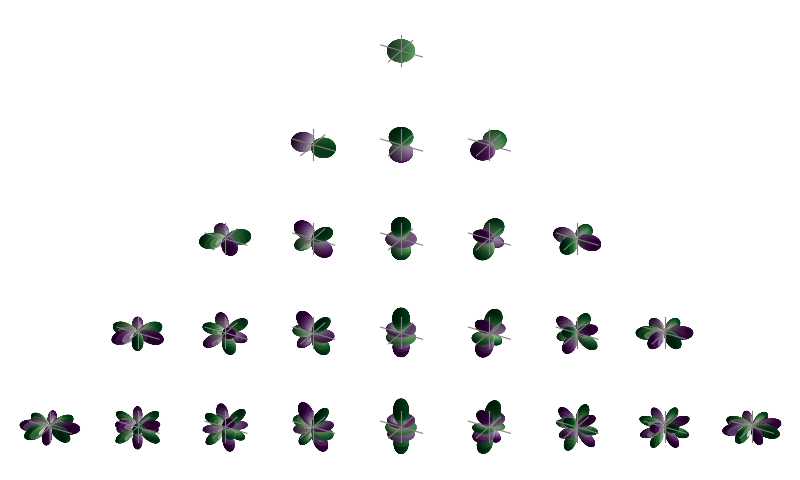Spherical Harmonics
Spherical harmonics are a class of function related to the associated
Legendre polynomials by the expression
\[\label{eq:spharmonicdef}
Y_{lm}(\theta, \phi) = \qty[ \frac{2l+1}{4 \pi} \frac{(l-|m|)!}{(l+|m|)!}]^{\frac{1}{2}} P_l^m (\cos(\theta)) e^{im\phi}\]
Spherical harmonics with a negative \(m\) value can be related to
those with a positive \(m\) value via

\[ \begin{align}\begin{aligned} \label{eq:negativespharm}
Y_{l, -m} (\theta, \phi) = (-1)^m Y^{*}_{lm} (\theta, \phi)\\and they are orthogonal,\end{aligned}\end{align} \]
\[ \begin{align}\begin{aligned} \label{eq:spahrmorthog}
\int \dd{\Omega} Y^{*}_{lm} (\theta, \phi) Y_{l^{\prime}m^{\prime}}(\theta, \phi) = \delta_{l l^{\prime}} \delta_{m, m^{\prime}}\\The first few spherical harmonics are\end{aligned}\end{align} \]
\[Y_{00} = \sqrt{\frac{1}{4 \pi}}\]
\[Y_{10}= \sqrt{\frac{3}{4 \pi}} \cos(\theta)\]
\[Y_{1, \pm 1} = \mp \sqrt{\frac{3}{8 \pi}} \sin(\theta) e^{\pm i \phi}\]
Spherical Harmonics and the Schrodinger Equation
In spherical coordinates the time-independent Schrodinger equation is
\[ \begin{align}\begin{aligned}\begin{split} \label{eq:tisespherical}
\begin{split}
- \frac{\hbar^2}{2m} \frac{1}{r^2 \sin^2 \theta} \bigg( \pdv{r} \qty[ r^2 \sin(\theta) \pdv{\psi}{r}]
+ \pdv{\theta} \qty[ \sin \theta \pdv{\psi}{\theta}] \\ + \pdv{\phi} \qty[ \frac{1}{\sin \theta} \pdv{\psi}{\phi}] \bigg)
+ (V-E)\psi = 0
\end{split}\end{split}\\Now, splitting this into the radial part and an angular part,\end{aligned}\end{align} \]
\[ \begin{align}\begin{aligned} \label{eq:sepschrod}
\psi(r, \theta, \phi) = R(r) Y(\theta, \phi)\\Then, substituting this in, and setting both sides of the equation\end{aligned}\end{align} \]
equal to \(l(l+1)\) we get two independent solutions
\[ \begin{align}\begin{aligned}\begin{split} \begin{aligned}
\dv{r} \qty[r^2 \dv[2]{R}{r}] - \frac{2m}{\hbar^2} \qty(V(r)-E) r^2
R - l(l+1) R &= 0 \\\frac{1}{\sin \theta} \pdv{\theta} \qty[ \sin
\theta \pdv{Y}{\theta}] + \frac{1}{\sin^2(\theta)}
\pdv[2]{Y}{\phi} +l(l+1)Y &= 0\end{aligned}\end{split}\\The angular part is solved by spherical harmonics,\end{aligned}\end{align} \]
\[\label{eq:sphericalharmonics}
Y_l^m(\theta, \phi) = N e^{im\phi} P_l^m (\cos \theta)\]